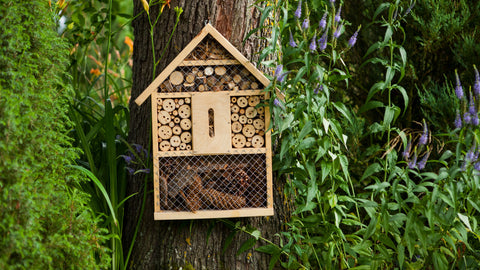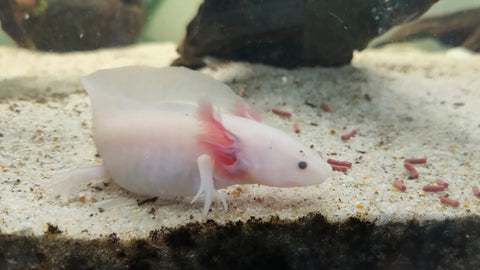The perfect insect hotel for your garden or balcony
Insect hotels are becoming increasingly popular, and for good reason. Not only do they provide useful accommodation for many beneficial insect species, they also contribute to biodiversity and can add aesthetic value to your garden or balcony.
In this article, we at AQUATANA would like to take a closer look at the benefits and different types of insect hotels, as well as the correct placement, care and maintenance of insect hotels.
You can also find some great insect hotels in our garden and pet supplies shop.
Why buy or make an insect hotel?
Insects play a crucial role in our ecosystem. They pollinate plants, decompose organic material and serve as a food source for many other animals. An insect hotel can help to colonise these useful little helpers in your garden or on your balcony and support their population. There are a number of important benefits of insect hotels, which we would like to explain to you in more detail.
Promotion of pollination
Bees and other pollinating insects find a safe haven in an insect hotel and can therefore help your flowers, fruit trees and vegetable plants to thrive.
Natural pest control
Many insects that find shelter in insect hotels eat pests such as aphids, caterpillars and spider mites. This means that in many cases you can dispense with chemical pesticides and still maintain a healthy garden or balcony.
Preservation of biodiversity
By providing a habitat for various insect species, you contribute to the preservation of biodiversity, which in turn strengthens the entire ecosystem.
Educational value
An insect hotel offers a great opportunity to learn more about the behaviour and way of life of insects. It is particularly exciting for children to observe the various inhabitants and learn more about nature.
Different types of insect hotels
There are many different types of insect hotels, which vary in size, shape and materials. In this section of our article, we would like to introduce you to the most common insect hotels.
Wild bee hotel
These hotels usually consist of wooden blocks or discs with holes of different sizes. They provide an ideal nesting place for various species of wild bees.
Butterfly hotel
These special hotels have narrow, vertical slits in which butterflies can retreat. They are often filled with a mixture of dried leaves or pieces of bark.
Ladybird house
Ladybird houses often consist of small boxes or tubes filled with wood wool or straw. They offer ladybirds and other beneficial beetles protection and a place to overwinter.
Earwig pot
A simple but effective shelter for earwigs is an inverted clay pot filled with straw or wood wool and hung in a tree or shrub.
Materials for building an insect hotel
The materials you use for an insect hotel play an important role in the attractiveness and safety of the shelter. In this section, we at AQUATANA would like to take a closer look at some of the most commonly used materials.
Wood
Untreated hardwood such as oak, beech or ash is ideal for insect hotels. However, avoid treated woods at all costs, as these may contain harmful chemicals and this can cause damage to the insects.
Bamboo and reeds
These materials are ideal for wild bee hotels as they have hollow stems in which the bees can lay their eggs.
Loam and clay
These materials provide a natural and breathable structure for many insect species. They can also be used to seal the holes in wooden blocks.
Pine cones, bark and straw
These materials provide hiding places for smaller insects and are ideal for filling larger insect hotels.
Placement of the insect hotel
The correct placement of your insect hotel in the garden or on the balcony is crucial to its success. Here are some tips for finding the best location.
Sunny and sheltered from the wind
Most insects prefer warm and dry places. Place the insect hotel in a sunny, sheltered spot, ideally facing south.
Near plants
Place the insect hotel near flowering plants, herbs or vegetable patches. This gives the insects a nearby source of food.
Safe from predators
If possible, hang the insect hotel at a height of at least one metre to protect it from birds and other predators.
Stable and weatherproof
Make sure that the insect hotel is sturdily attached and weatherproof so that it can withstand the elements and provide long-term protection for the insects.
Care and maintenance of the insect hotel
An insect hotel requires minimal care, but a few regular maintenance tasks can increase its lifespan and effectiveness.
Annual cleaning
Remove dead plant debris and clean the tubes and holes to prevent mould growth. Do not use chemical cleaning agents.
Replacing the materials
Replace old, worn materials such as straw or bark regularly to keep the hotel attractive and safe for insects.
Monitoring
Regularly monitor the activity in your insect hotel and, if necessary, make adjustments to the placement or materials to better meet the needs of the insects.
As you will have realised, an insect hotel is a wonderful way to bring nature into your garden or balcony and make a positive contribution to environmental protection.
With the right planning, placement and care, you can create an attractive and useful home for many different insect species.
Whether you buy a ready-made insect hotel or build one yourself, you will quickly realise the benefits and enjoy observing the exciting world of insects up close.




Comments (0)
There are no comments for this article. Be the first one to leave a message!